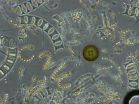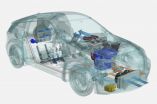INFORMATION:
This research was supported by the Department of Defense through the National Defense Science and Engineering Graduate Fellowship Program, and funds from the National Science Foundation Environmental Genomics and Biological Oceanography Programs, and the Joint Genome Institute/Department of Energy Community Sequencing Program. A grant to the National Center for Genome Resources for the MMETSP was provided by the Gordon and Betty Moore Foundation.
The Woods Hole Oceanographic Institution is a private, non-profit organization on Cape Cod, Mass., dedicated to marine research, engineering, and higher education. Established in 1930 on a recommendation from the National Academy of Sciences, its primary mission is to understand the ocean and its interaction with the Earth as a whole, and to communicate a basic understanding of the ocean's role in the changing global environment. For more information, please visit http://www.whoi.edu.
Coexisting in a sea of competition
Similar diatom species seek out nutrients in different ways
2015-04-13
(Press-News.org) Diversity of life abounds on Earth, and there's no need to look any farther than the ocean's surface for proof. There are over 200,000 species of phytoplankton alone, and all of those species of microscopic marine plants that form the base of the marine food web need the same basic resources to grow--light and nutrients.
A study by a team of scientists from the Woods Hole Oceanographic Institution (WHOI), University of Rhode Island (URI), and Columbia University, published April 13 in the Proceedings of the National Academy of Sciences reveals how species of diatoms--one of the several major types of marine phytoplankton--use resources in different ways to coexist in the same community.
"The diversity of phytoplankton has puzzled biological oceanographers for a long time," says Harriet Alexander, the study's lead author and a graduate student in the MIT-WHOI Joint Program in Oceanography. "Why are there so many different species coexisting in this relatively stable environment, when they're competing for the same resources? Why hasn't a top competitor forced others into extinction?"
To try and answer those questions, Alexander and her colleagues used a novel approach combining new molecular and analytic tools to highlight how similar species utilize resources differently--known as niche partitioning--in Narragansett Bay, R.I.
"The phytoplankton of Narragansett Bay, which is a dynamic estuarine system, have been investigated on a weekly basis since the 1950's, giving us great insight into long term patterns of change," says Tatiana Rynearson, a coauthor and the director of the Narragansett Bay Plankton Time Series at URI. "This study uses that time series, but takes it in an entirely new direction, providing insights into the inner lives of phytoplankton."
Working with water samples collected in conjunction with surveys for the Plankton Time Series from the R/V Cap'n Bert, the research team extracted genetic material called ribonucleic acid (RNA) from the plankton in the bay. RNA sequencing, which was done at the Columbia University Genome Center, allowed the researchers to use the genetic information to determine what organisms were present and what they were doing. The annotation of these RNA sequences via "pattern matching" was facilitated by the Gordon and Betty Moore Foundation's Marine Microbial Eukaryote Transcriptome Sequencing Project, which has sequenced the genetic material of more than 300 marine species.
In conjunction with the sequencing analysis, the research team developed a new bioinformatic approach that uses data from nutrient amendment experiments to help interpret signals from the environment.
"By adding nitrogen, we can get an idea of what these organisms look like and how they behave when they have plenty of nitrogen," explains Alexander. "Then we would also do the converse, by adding everything that they could possibly want except nitrogen. Creating these extremes in nutrient environment enabled the identification of known and novel molecular markers of nutrient condition for these organisms."
Using these data the researchers observed two species of chain-forming diatoms--Skeletonema spp. and Thalassiosira rotula--coexisting in the same parcel of water, but doing fundamentally different things with available nutrients, specifically nitrogen and phosphorus.
"Skeletonema was the dominant player during our sampling and goes after inorganic nitrogen sources, like nitrate and nitrite. As the less dominant player, Thalassiosira, is doing a lot of work bringing in nitrogen from organic sources, such as amino acids," Alexander says.
"We have long suspected that even closely related phytoplankton must have ways of distinguishing their needs from that of their neighbors, for example using different forms phosphorus or nitrogen, but this has been hard to track in the environment, as most approaches are not species-specific," adds Alexander's advisor and coauthor on the study, Sonya Dyhrman, an associate professor in the Department of Earth and Environmental Sciences at Columbia University.
"Part of the challenge is that you would need to track species-specific patterns in resource utilization to compare one diatom to another," adds Dyhrman. "In this study, a new database that is part of the MMETSP was leveraged to identify species-specific signals, and then Harriet developed a way to normalize those signals to be able to compare quantitatively between species."
Much like human genome sequencing is expanding our understanding of medicine, microbial genomics gives us new insights into how marine organisms function in the ocean and how they are influenced by environmental factors such as climate. The tools developed in this study, point the way to further work that examines how diverse populations of diatoms and other phytoplankton will respond to changing conditions in the future ocean.
ELSE PRESS RELEASES FROM THIS DATE:
Network 'hubs' in the brain attract information, much like airport system
2015-04-13
ANN ARBOR, Mich. - One of the brain's main jobs is information processing - what is critical, however, is that information in the brain gets transferred to the right places at the right times.
Research on large-scale brain networks by the University of Michigan Medical School reveals that "hubs" in the brain - highly connected regions that like hubs of the airport system - tend to consistently attract information flow.
"Understanding how information transfer occurs in the brain is critical, especially if network hubs are taken off line by anesthesia, tumor or stroke," ...
Passenger-focused air conditioning
2015-04-13
This news release is available in German.
How can a pleasant vehicle climate be achieved efficiently? Researchers at the Technische Universität München (TUM) pursued this question in the context of the research project Visio.M funded by the German Federal Ministry for Education and Research (BMBF) with a total of 7.1 million euro. The results of their research show that the potential of energy efficient air conditioning is all but exhausted. And this applies also to gasoline powered cars.
Inefficiency has its advantages, too: In the past, waste heat ...
Certain genes might make some people more prone to experience the placebo effect
2015-04-13
Researchers are beginning to explore whether the genetics of patients who experience a placebo effect are different from those of patients who don't. It's well known that people can feel better if they believe they are receiving treatment, but the biological pathways involved are relatively unexplored. In a new review, publishing April 13 in Trends in Molecular Medicine, scientists at Beth Israel Deaconess Medical Center discuss what we know as well as possible ethical issues related to conducting genetic tests to determine whether a patient is a placebo responder.
"Understanding ...
New strategy can help determine heart attack in patients within 1 hour
2015-04-13
A new strategy to rule-out and rule-in heart attacks in emergency departments will help physicians treat patients faster, found a clinical trial published in CMAJ (Canadian Medical Association Journal).
Acute myocardial infarction (MI) is a common cause of death and disability around the world. Early diagnosis is critical for treatment and survival.
Swiss and Spanish researchers conducted a clinical trial to determine whether a new technique, previously tested in a small pilot study, would be effective in determining whether a patient has had a heart attack. They enrolled ...
Family doctors important in advising young women on egg freezing for future fertility
2015-04-13
Family physicians have an important role in advising women about the benefits and risks of egg freezing, argues an analysis in CMAJ (Canadian Medical Association Journal).
"With growing public awareness of social egg freezing, Canadian women may increasingly approach physicians in search of information and advice about the procedure," writes Dr. Angel Petropanagos, Faculty of Medicine, Dalhousie University, Halifax, Nova Scotia, with coauthors Alana Cattapan, Françoise Baylis and Arthur Leader. "Family physicians are uniquely positioned at the front lines of medical ...
Melanoma's 'safe haven' targeted for shut-down
2015-04-13
Melanoma cells become drug resistant by using surrounding healthy cells to provide a 'safe haven' from treatment, according to new research* published in Cancer Cell today (Monday).
Around half of melanomas are caused by a mutation in a gene called BRAF. Drugs called BRAF inhibitors treat these melanomas by targeting the faulty gene. But these cancers can quickly develop resistance to these targeted treatments.
Scientists at the Francis Crick Institute, funded by Cancer Research UK, and at the Cancer Research UK Manchester Institute have discovered that a side effect ...
Promising developments in tackling resistance to blood cancer drugs
2015-04-13
A drug with the potential to reverse resistance to immunotherapy has been developed by scientists at the University of Southampton. It has shown great promise in pre-clinical models and will be available to patients with certain leukaemias and non-Hodgkin lymphomas in clinical trials later this year.
Targeted drugs made from engineered immune proteins - called monoclonal antibodies - have revolutionised treatment for several types of cancer in recent years. They work by sticking to specific proteins found on the surface of cancer cells, flagging them up to be killed by ...
The placebome: Where genetics and the placebo effect meet
2015-04-13
BOSTON -Placebos have helped to ease symptoms of illness for centuries and have been a fundamental component of clinical research to test new drug therapies for more than 70 years. But why some people respond to placebos and others do not remains under debate.
With the advent of genomics, researchers are learning that placebo responses are modified by a person's genetics, a discovery that raises important new questions regarding the role of the placebo in patient care and in drug development: How many genetic biomarkers exist? Can the medical field harness the placebo ...
Tradition is more important than education in determining participation European immigrant women's role in the workforce
2015-04-13
This news release is available in Spanish. Through his latest research, Javier Polavieja, a professor Sociology in the Social Sciences Department who holds a UC3M- Santander Named Chair of (Cátedra de Excelencia), has shown how European women who emigrate to other countries within the same continent take the cultural norms of their home countries with them. Those norms are decisive when it comes to determining their work behavior.
To reach this conclusion, the researcher compared the attitudes of over three thousand immigrant women from some twenty European countries ...
Tango dancing benefits Parkinson's patients
2015-04-13
This news release is available in French.
Dancing the Argentine tango could have potential benefits for people at certain stages in the development of Parkinson's disease (PD), according to findings in a new study by researchers at the Montreal Neurological Institute and Hospital -The Neuro, McGill University and the Research Institute of the McGill University Health Centre. The study looked at changes in patients' motor abilities following a 12-week tango course, and is also the first study to assess the effect that tango has on non-motor symptoms.
The study looked ...
LAST 30 PRESS RELEASES:
Numbers in our sights affect how we perceive space
SIMJ announces global collaborative book project in commemoration of its 75th anniversary
Air pollution exposure and birth weight
Obstructive sleep apnea risk and mental health conditions among older adults
How talking slows eye movements behind the wheel
The Ceramic Society of Japan’s Oxoate Ceramics Research Association launches new international book project
Heart-brain connection: international study reveals the role of the vagus nerve in keeping the heart young
Researchers identify Rb1 as a predictive biomarker for a new therapeutic strategy in some breast cancers
Survey reveals ethical gaps slowing AI adoption in pediatric surgery
Stimulant ADHD medications work differently than thought
AI overestimates how smart people are, according to HSE economists
HSE researchers create genome-wide map of quadruplexes
Scientists boost cell "powerhouses" to burn more calories
Automatic label checking: The missing step in making reliable medical AI
Low daily alcohol intake linked to 50% heightened mouth cancer risk in India
American Meteorological Society announces Rick Spinrad as 2026 President-Elect
Biomass-based carbon capture spotlighted in newly released global climate webinar recording
Illuminating invisible nano pollutants: advanced bioimaging tracks the full journey of emerging nanoscale contaminants in living systems
How does age affect recovery from spinal cord injury?
Novel AI tool offers prognosis for patients with head and neck cancer
Fathers’ microplastic exposure tied to their children’s metabolic problems
Research validates laboratory model for studying high-grade serous ovarian cancer
SIR 2026 delivers transformative breakthroughs in minimally invasive medicine to improve patient care
Stem Cell Reports most downloaded papers of 2025 highlight the breadth and impact of stem cell research
Oxford-led study estimates NHS spends around 3% of its primary and secondary care budget on the health impacts of heat and cold in England
A researcher’s long quest leads to a smart composite breakthrough
Urban wild bees act as “microbial sensors” of city health.
New study finds where you live affects recovery after a hip fracture
Forecasting the impact of fully automated vehicle adoption on US road traffic injuries
Alcohol-related hospitalizations from 2016 to 2022
[Press-News.org] Coexisting in a sea of competitionSimilar diatom species seek out nutrients in different ways


